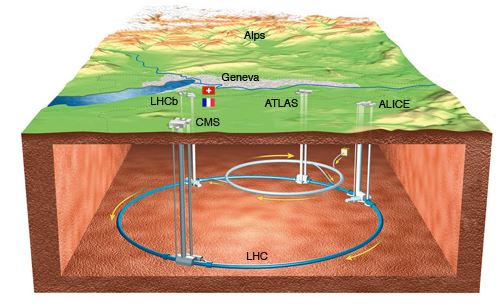

6th July 2022 (9 Topics)
Context
The Large Hadron Collider beauty (LHCb) experiment — which is investigating the slight differences between matter and antimatter by studying a type of particle called the “beauty quark”, or “b quark” has observed three never-before-seen particles.
About
Large Hadron Collider beauty (LHCb) experiment
- The Large Hadron Collider beauty (LHCb) experiment specializes in investigating the slight differences between matter and antimatter.
- Instead of surrounding the entire collision point with an enclosed detector as do ATLAS and CMS, the LHCb experiment uses a series of subdetectors to detect mainly forward particles – those thrown forwards by the collision in one direction.
- The first subdetector is mounted close to the collision point, with the others following one behind the other over a length of 20 metres.
- The LHCb experiment is situated at one of the four points around CERN’s Large Hadron Collider where beams of protons are smashed together, producing an array of different particles.
How does it work?
- The aim of the LHCb experiment is to record the decay of particles containing b and anti-b quarks, collectively known as ‘B mesons’.
- Rather than flying out in all directions, B mesons formed by the colliding proton beams (and the particles they decay into) stay close to the line of the beam pipe, and this is reflected in the design of the detector.
New Finding:
- The three “exotic” additions, a new kind of “pentaquark” and the first-ever pair of “tetraquarks”, to the growing list of new hadrons found at the LHC will help physicists better understand how quarks bind together into these composite particles.
- The first kind was observed in an analysis of “decays” of negatively charged B mesons.
- It is a pentaquark made up of a charm quark and a charm antiquark, and an up, a down, and a strange quark.
- It is the first pentaquark found to contain a strange quark.
- The second kind is a doubly electrically charged tetraquark.
- It is an open-charm tetraquark composed of a charm quark, a strange antiquark, and an up quark and a down antiquark.
- It was spotted together with its neutral counterpart in a joint analysis of decays of positively charged and neutral B mesons.
What are quarks?
- Quarks are elementary particles that come in six “flavours”: up, down, charm, strange, top, and bottom.
- They usually combine together in groups of twos and threes to form hadrons such as the protons and neutrons that make up atomic nuclei.
- But they can also combine into four-quark and five-quark particles, called tetraquarks and pentaquarks.
- These exotic hadrons were predicted by theorists about six decades ago, around the same time as conventional hadrons but they have been observed by LHCb and other experiments only in the past 20 years.
|
About CERN
|




